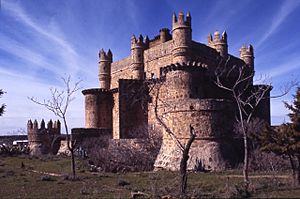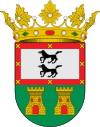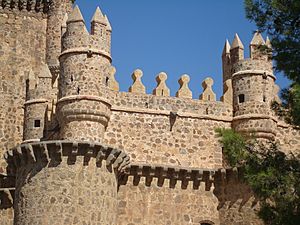Guadamur facts for kids
Quick facts for kids
Guadamur, Spain
|
|||
|---|---|---|---|
|
|||
| Country | Spain | ||
| Autonomous community | Castile-La Mancha | ||
| Province | Toledo | ||
| Municipality | Guadamur | ||
| Area | |||
| • Total | 37 km2 (14 sq mi) | ||
| Elevation | 640 m (2,100 ft) | ||
| Population
(2018)
|
|||
| • Total | 1,781 | ||
| • Density | 48.1/km2 (124.7/sq mi) | ||
| Time zone | UTC+1 (CET) | ||
| • Summer (DST) | UTC+2 (CEST) | ||
Guadamur is a town located in the province of Toledo, in the Castile-La Mancha region of Spain. In 2018, the town had a population of about 1,781 people.
On June 4, 2007, Guadamur signed a special agreement with two towns: Vouillé in France and Tournai in Belgium. This agreement helps promote cultural exchanges between the towns. It also celebrates the 1500th anniversary of the Battle of Vouillé. In that battle, near Poitiers, Clovis I, king of the Franks, defeated the Visigoths in the year 507. Tournai was the first capital of the Franks under kings Clovis and Childericus.
Contents
The Name of Guadamur
The name "Guadamur" is thought to come from an Arabic term. Some experts believe it means 'the river of the waves'. Others suggest it comes from 'wadi al-mur', meaning 'river of the wall'.
This second idea refers to an ancient Roman or Visigothic water structure. A "wadi" is an Arabic word for a river valley that is often dry. However, it can have sudden, dangerous water surges.
History of Guadamur
Early Beginnings

It is rare to find very old remains from before our era in Guadamur. However, a few stone tools, like a Neolithic scraper and a hatchet, have been found. It is hard to know exactly when they were made. Guadamur is quite far from the Paleolithic settlements found nearby in the province of Madrid.
People living in this area before the Romans arrived were called Carpetani by the geographer Strabo. Near Guadamur, there are Celtic place names like Alpuébrega and Castrejón.
Archaeological finds show that Romans were present in and around the town. These finds include coins, a cameo, a stone slab, and a horse brake from the 2nd century. There are also pieces reused by the Visigoths, as well as parts of columns and statues made of Carrara marble. While there wasn't a specific Roman settlement in Guadamur, it seems there was a Roman road. A Roman villa might have existed near the old road to Toledo. The local name Portusa, a crossing point of the Tagus River, suggests this area was a place people traveled through.
Middle Ages in Guadamur
The Visigothic period (409-711 AD) is a very important time in Guadamur's history. In August 1858, heavy storms in Guadamur uncovered some tombs at a place called Guarrazar. Two neighbors, Francisco Morales and María Pérez, accidentally found the Treasure of Guarrazar. This treasure is the most important Visigothic find in Spain.
Other neighbors and an archaeological dig in 1859 found more items. These included six crowns, five crosses, and other gold pieces. Many of these are now in the National Archaeological Museum in Madrid. Some pieces, like three crowns and two crosses, are in the Musée de Cluny in Paris. The most valuable item is the crown of King Recesvinto. Its blue sapphire parts came all the way from Sri Lanka!
Archaeologists also found parts of sculptures and an old building. This building might have been a Roman temple that later became a Christian church. It contained several graves. In one important grave, a skeleton was found with a stone slab. This slab had a Latin message mentioning a priest named Crispín and dated to 693 AD. This slab is also in the National Archaeological Museum in Madrid. Some people believe Guarrazar was a monastery. It might have hidden royal treasures to keep them safe from the Muslims.
Besides its own name, Guadamur has other names nearby that come from Arabic. Examples include Daramazán, meaning "fortified home," and Guarrazar, meaning "valley of lead."
When Toledo surrendered in 1085, the Almohades and Almoravids tried to take it back from the Christians. For the next hundred years, the region was often attacked by both sides. Guadamur was a village council of Toledo, paying taxes and following its laws. Records show that people from Toledo owned private land around Guadamur, some with Arabic names from the earlier Taifa kingdom. By the late 12th century, much of this land went to the church.
During the 13th, 14th, and 15th centuries, the land slowly became part of a noble system. People faced hardship due to a weakening monarchy, strong nobles, peasant resistance, religious conflicts, and diseases like the plague. Guadamur became part of medieval history through Pedro López Ayala. His family fought with the Silva family for control of Toledo. In 1446, King Juan II gave Guadamur to Pedro López Ayala. This started four centuries of the manorial system in the town. This meant a landlord had absolute power, judging, punishing, and taxing the people.
Pedro's son became the first Count of Fuensalida in 1470. Two years earlier, he got permission to build a castle in Guadamur. This castle was probably built on an older Arabic watchtower. It shows the symbols of the Ayala and Silva families. The nearby shrine of Our Lady of the Nativity also dates from the 15th century and shows the Mudéjar style.
Modern Age in Guadamur
In 1471, Guadamur officially became a town. Around this time, a pillory was built in the town square. This was a symbol of justice and punishment, replacing an older wooden gallows. A nearby hill is still called "Cerro de la Horca" (Gallows Hill).
The third Count of Fuensalida (1489–1537) hosted Prince Don Felipe and Doña Juana in Guadamur on July 11, 1502. They had just been named heirs to the Crown of Castile. In 1590, during the reign of Philip II, the castle was used as a secret prison by the Inquisition. The sixth Count helped expel the Moors in 1609, gathering 126 young men from Guadamur. The ninth Count was made Captain General of Sardinia and Milan by Charles II. In the 17th century, the Fuensalida County grew very large, becoming the second largest estate in the kingdom of Toledo. The manorial system in Guadamur ended in 1843 when the government gave the noble properties to the town's residents.
In the 16th century, Guadamur had two large pastures. One was used by sheep herds. The other had many beehives, producing a lot of honey and beeswax. The archbishop of Toledo, Silíceo, built a bridge over the Guajaraz River around this time. The parish church of St. Mary Magdalene and the hermitage of San Antonio Abad also date from this period. The chapel now houses the Museum of Popular Arts and Customs of the Montes de Toledo.
Contemporary History
French Invasion and 19th Century Changes
At the end of 1808, a group of French cavalry, part of Napoleon's army, arrived in Guadamur. They stayed in the castle, which was empty but still in good condition. Documents from 1811 show that the village helped supply the French troops. Some young people from Guadamur joined a guerrilla group led by Ambrosio Carmena to resist the French.
In September 1812, the people of Guadamur officially supported the Constitution of Cadiz. In the 19th century, many church properties were sold. This affected Guadamur because many residents had rented land from the Catholic Church. When the land was sold, some new owners ended contracts or raised rents. However, some tenants in the village were able to buy the lands themselves.
The town's Municipal Music Band was started in 1834 and is still active today. The Constitution of 1837 allowed for the creation of militias, which were military groups made up of local residents. The Guadamur militia was called upon several times to fight Carlists hiding in the Montes de Toledo. Farmers often suffered from cattle theft, so they created an agreement to help each other in such cases.
Mines and Modern Utilities
The mining of the ground in Guadamur dates back to at least 1612. At that time, a lead mine and a kohl mine (used in cosmetics) were active. Mining became more important with the graphite mine in the late 19th century. This mine employed up to 110 workers and produced up to 400 metric tons annually in 1963. It closed because of competition from German graphite.
In 1887, the town sold the castle to the sixth Count of Asalto. His son, the Marquis de Argüeso, helped get telephone service for Guadamur in 1922. The castle was recognized as a historical monument in 1964. In the late 19th century, a new public well was built in Recesvinto Square. Water did not reach the houses of Guadamur until 1928, after electricity arrived in 1907.
The Second Spanish Republic
When the Second Spanish Republic began, the first labor union, the General Union of Workers (UGT), was created in Guadamur. Its local office was on San Antón street. Construction of the Public Schools began in 1935. Today, this building houses the Center of Treasure of Guarrazar. The new government also built Nueva street, where many laborers and small farmers lived.
After the military uprising on July 18, 1936, Guadamur remained under the control of the Second Spanish Republic during the Spanish Civil War. In November 1936, a group of militia members from Guadamur was formed. By December, the City Council resumed its regular meetings. It was made up of seven councilors from the Spanish Federation of Workers of the Earth (FETT-UGT). During this time, Guadamur experimented with a system where the whole community worked together. Large farms were taken over, and land was divided into plots. The Committee managed supplies, trade, and the town's only tavern. The parish church and chapels became barns and warehouses. The castle was looted, including its library. The Municipal Council also issued its own local money.
On May 7, 1937, the Nationalist army broke through the front south of Toledo and entered the north of Guadamur. They captured the nearby town of Argés, but Republican forces took it back a few days later. In May, the 11th Division of the Republican People's Army held events in the area, including in Guadamur. In October 1937, the community system began to change. By October 1938, this system, which had become an agricultural cooperative, was dissolved. On March 27, 1939, Nationalist troops took control of the town.
Francoist Spain
After the Civil War, during the time of Francoist Spain, council members were chosen differently. They came from groups like heads of households, members of the official union, and "prestigious neighbors." Political parties were not allowed. In small towns like Guadamur, the mayor was appointed by the Provincial Governor.
Return to Democracy
On April 3, 1979, democratic elections were held again in Spain. Since then, mayors in Guadamur have been elected from different political parties, including UCD (Unión de Centro Democrático), PSOE (Partido Socialista Obrero Español), and PP (Partido Popular).
Images for kids
See also
 In Spanish: Guadamur para niños
In Spanish: Guadamur para niños







